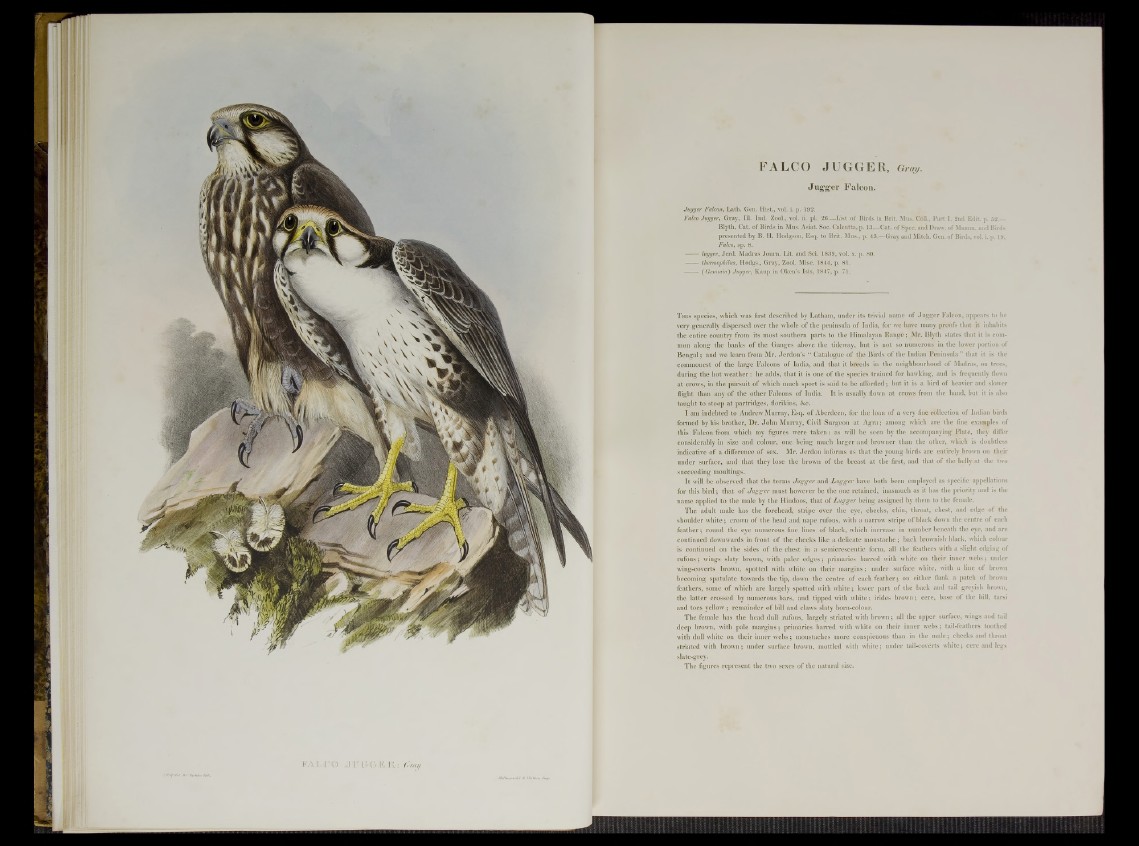
i V ,
FALCO JUGGER, Gray.
.Jugger Falcon.
Jugger Falcon, Lath. Gen. Hist., vol. i. p. 192.
Falco Jugger, Gray, 111. Ind. Zool., vol. ii. pi. 26.—List of Birds in Brit. Mus. Cóli., Part I. 2nd E d it p. 52.—
Blyth, Cat. of Birds in Mus. Asiat. Soc. Calcutta, p. 13.—Cat. of Spec, and Draw, of Mamm. and Birds
presented by B. H. Hodgson, Esq. to Brit. Mus., p. 43.—Gray and Mitch. Gen. of Birds, vol. i. p. 19,
Falco, sp. 8.
— — lugger, Jerd. Madras Joum. Lit. and Sci. 1839, vol. x. p. 80.
thermophilus, Hodgs., Gray, Zool. Misc. 1844, p. 81.
( Gennaio) Jugger, Kaup in Oken’s Isis, 1847, p. 71.
T his species, which was first described by Latham, under its trivial name of Jugger Falcon, appears to be
very generally dispersed over the whole of the peninsula of India, for we have many proofs that it inhabits
the entire country from its most southern parts to the Himalayan Rangé ; Mr. Blyth states that it is common
along the banks of the Ganges above the tideway, but is not so numerous in the lower portion of
Bengal; and we learn from Mr. Jerdon’s “ Catalogue of the Birds of the Indian Peninsula” that it is the
commonest of the large Falcons of India, and that it breeds in the neighbourhood of Madras, on trees,
during the hot weather : he adds, that it is one of the species trained for hawking, and is frequently flown
at crows, in the pursuit of which much sport is said to be afforded ; but it is a bird of heavier and slower
flight than any of the other Falcons of India. It is usually flown at crows from the hand, but it is also
taught to stoop at partridges, florikins, &c.
I am indebted to Andrew Murray, Esq. of Aberdeen, for the loan of a very fine collection of Indian birds
formed by his brother, Dr. John Murray, Civil Surgeon at Agra; among which are the fine examples of
this Falcon from which my figures were taken: as will be seen by the accompanying Plate, they differ
considerably in size and colour, one being much larger and browner than the other, which is doubtless
indicative of a difference of sex. Mr. Jerdon informs us that the young birds are entirely brown on their
under surface, and that they lose the brown of the breast at the first, and that of the belly at the two
succeeding moultings.
It will be observed that the terms Jugger and Lugger have both been employed as specific appellations
for this bird ; that of Jugger must however be the one retained, inasmuch as it has the priority and is the
name applied to the male by the Hindoos, that of Lugger being assigned by them to the female.
The adult male has the forehead, stripe over the eye, cheeks, chin, throat, chest, and edge of the
shoulder white ; crown of the head and nape rufous, with a narrow stripe of black down the centre of each
feather; round the eye numerous fine lines of black, which increase in number beneath the eye, and are
continued downwards in front of the cheeks like a delicate moustache ; back brownish black, which colour
is continued on the sides of the chest in a semicrescentic form, all the feathers with a slight edging of
rufous; wings slaty brown, with paler edges; primaries barred with white on their inner webs; under
wing-coverts brown, spotted with white on their margins ; under surface white, with a line of brown
becoming spatulate towards the tip, down the centre of each feather ; on either flank a patch of brown
feathers, some of which are largely spotted with white ; lower part of the back and tail greyish brown,
the latter crossed by numerous bars, and tipped with white ; irides brown ; cere, base of the bill, tarsi
and toes yellow ; remainder of bill and claws slaty horn-colour.
The female has the head dull rufous, largely striated with brown ; all the upper surface, wings and tail
deep brown, with pale margins ; primaries barred with white on their inner webs ; tail-feathers toothed
with dull white on their inner webs ; moustaches more conspicuous than in the male ; cheeks and throat
striated with brown ; under surface brown, mottled with white ; under tail-covérts white ; cere and legs
slate-grey.
The figures represent the two sexes of the natural size.